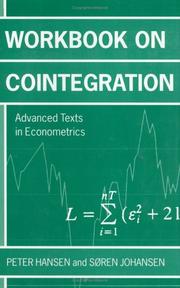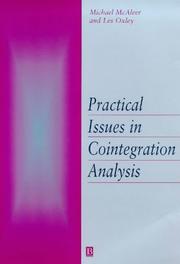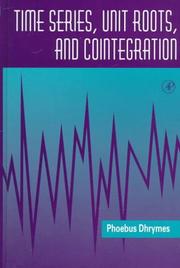| Listing 1 - 10 of 57 | << page >> |
Sort by
|
Book
Year: 2018 Publisher: [Place of publication not identified] : MDPI - Multidisciplinary Digital Publishing Institute,
Abstract | Keywords | Export | Availability | Bookmark
 Loading...
Loading...Choose an application
- Reference Manager
- EndNote
- RefWorks (Direct export to RefWorks)
The Cointegrated VAR model allows the user to study both long-run and short-run effects in the same model. It describes an economic system where variables have been pushed away from long-run equilibria by exogenous shocks (the pushing forces) and where short-run adjustments forces pull them back toward long-run equilibria (the pulling forces). In this model framework, basic assumptions underlying an economic theory model can be translated into testable hypotheses of the order of integration and cointegration of key variables and their relationships. While the latter used to be I(1), macroeconomic and financial data have recently shown a tendency for puzzling long and persistent swings around long-run equilibrium values typical of self-reinforcing feed-back mechanisms. Such persistent fluctuations are frequently indistinguishable from I(2) data, pointing to the need for new econometric solutions. In this book, many of our most distinguished scholars in the field of cointegration offer a variety of solutions to these problems by formulating new models, tests, and asymptotics more suitable for an I(2) world. Several of the papers apply these cointegration techniques to a variety of empirical problems, thereby showing how to obtain valuable information about some of the mechanisms that have generated the recent crises.
Book
Year: 2018 Publisher: [Place of publication not identified] : MDPI - Multidisciplinary Digital Publishing Institute,
Abstract | Keywords | Export | Availability | Bookmark
 Loading...
Loading...Choose an application
- Reference Manager
- EndNote
- RefWorks (Direct export to RefWorks)
The Cointegrated VAR model allows the user to study both long-run and short-run effects in the same model. It describes an economic system where variables have been pushed away from long-run equilibria by exogenous shocks (the pushing forces) and where short-run adjustments forces pull them back toward long-run equilibria (the pulling forces). In this model framework, basic assumptions underlying an economic theory model can be translated into testable hypotheses of the order of integration and cointegration of key variables and their relationships. While the latter used to be I(1), macroeconomic and financial data have recently shown a tendency for puzzling long and persistent swings around long-run equilibrium values typical of self-reinforcing feed-back mechanisms. Such persistent fluctuations are frequently indistinguishable from I(2) data, pointing to the need for new econometric solutions. In this book, many of our most distinguished scholars in the field of cointegration offer a variety of solutions to these problems by formulating new models, tests, and asymptotics more suitable for an I(2) world. Several of the papers apply these cointegration techniques to a variety of empirical problems, thereby showing how to obtain valuable information about some of the mechanisms that have generated the recent crises.
Book
ISBN: 9122016848 Year: 1995 Publisher: Göteborg Almqvist och Wiksell
Abstract | Keywords | Export | Availability | Bookmark
 Loading...
Loading...Choose an application
- Reference Manager
- EndNote
- RefWorks (Direct export to RefWorks)
Cointegration --- Econometrics --- Economics, Mathematical --- Statistics --- Cointegration. --- Econometrics.
Book
ISBN: 9051701764 Year: 1992 Publisher: Amsterdam Thesis publ.
Abstract | Keywords | Export | Availability | Bookmark
 Loading...
Loading...Choose an application
- Reference Manager
- EndNote
- RefWorks (Direct export to RefWorks)
Book
ISBN: 3038429562 Year: 2018 Publisher: Basel : MDPI - Multidisciplinary Digital Publishing Institute,
Abstract | Keywords | Export | Availability | Bookmark
 Loading...
Loading...Choose an application
- Reference Manager
- EndNote
- RefWorks (Direct export to RefWorks)
The Cointegrated VAR model allows the user to study both long-run and short-run effects in the same model. It describes an economic system where variables have been pushed away from long-run equilibria by exogenous shocks (the pushing forces) and where short-run adjustments forces pull them back toward long-run equilibria (the pulling forces). In this model framework, basic assumptions underlying an economic theory model can be translated into testable hypotheses of the order of integration and cointegration of key variables and their relationships. While the latter used to be I(1), macroeconomic and financial data have recently shown a tendency for puzzling long and persistent swings around long-run equilibrium values typical of self-reinforcing feed-back mechanisms. Such persistent fluctuations are frequently indistinguishable from I(2) data, pointing to the need for new econometric solutions. In this book, many of our most distinguished scholars in the field of cointegration offer a variety of solutions to these problems by formulating new models, tests, and asymptotics more suitable for an I(2) world. Several of the papers apply these cointegration techniques to a variety of empirical problems, thereby showing how to obtain valuable information about some of the mechanisms that have generated the recent crises.
Cointegration. --- Econometrics. --- Economics, Mathematical --- Statistics --- Econometrics
Book
ISBN: 3631329628 Year: 1998 Publisher: Frankfurt am Main Lang
Abstract | Keywords | Export | Availability | Bookmark
 Loading...
Loading...Choose an application
- Reference Manager
- EndNote
- RefWorks (Direct export to RefWorks)
Cointegration --- Correlation (Statistics) --- Economics --- Statistical methods

ISBN: 0198776071 9780198776079 Year: 1998 Publisher: Oxford Oxford university press
Abstract | Keywords | Export | Availability | Bookmark
 Loading...
Loading...Choose an application
- Reference Manager
- EndNote
- RefWorks (Direct export to RefWorks)
Cointegration --- Econometrics --- 330.115 --- 330.015195 --- Economics, Mathematical --- Statistics --- Econometrie --- Cointegration. --- Econometrics. --- Econometrie. --- 330.115 Econometrie

ISBN: 0631211985 9780631211983 Year: 1999 Publisher: Oxford Blackwell
Abstract | Keywords | Export | Availability | Bookmark
 Loading...
Loading...Choose an application
- Reference Manager
- EndNote
- RefWorks (Direct export to RefWorks)
Cointegration --- 330.115 --- 330.015195 --- Econometrics --- Econometrie --- Cointegration. --- 330.115 Econometrie

ISBN: 0122146956 9780122146954 Year: 1998 Publisher: San Diego (Calif.) : Academic press,
Abstract | Keywords | Export | Availability | Bookmark
 Loading...
Loading...Choose an application
- Reference Manager
- EndNote
- RefWorks (Direct export to RefWorks)
Econometrics --- Cointegration --- Time-series analysis --- Stochastic analysis --- Econometrics. --- Cointegration. --- Time-series analysis. --- Stochastic analysis.
Book
Year: 1997 Publisher: Bern : Peter Lang International Academic Publishers,
Abstract | Keywords | Export | Availability | Bookmark
 Loading...
Loading...Choose an application
- Reference Manager
- EndNote
- RefWorks (Direct export to RefWorks)
Der Europäische Rat entscheidet 1998, welche Länder an der 1999 beginnenden Währungsunion teilnehmen werden. Sechs Jahre nach der Unterzeichnung der Maastricht-Verträge steht dem Konvergenzfortschritt bei der Preis- und Zinsentwicklung eine unzureichende Konvergenz bei der Finanzlage der öffentlichen Haushalte entgegen. Die Eingangsvoraussetzungen werden zu einer unüberwindbaren Hürde auf dem Weg zur Eurowährung, wenn der fehlende Konvergenzerfolg darauf zurückzuführen ist, daß die vier Kriterien nicht gleichzeitig erfüllbar sind. Die Arbeit liefert die ökonomische Begründung dafür, warum ein Mitgliedstaat der EU, mit dem Hinweis auf die mit dem verfügbaren wirtschaftspolitischen Instrumentarium nicht lösbaren Konsistenzprobleme der Maastricht-Kriterien, seine Teilnahme an der Einheitswährung in Europa einfordern könnte.
Convergence (Economics) --- Finance --- Cointegration. --- Econometric models. --- European Union countries.
| Listing 1 - 10 of 57 | << page >> |
Sort by
|

 Search
Search Feedback
Feedback About UniCat
About UniCat  Help
Help News
News